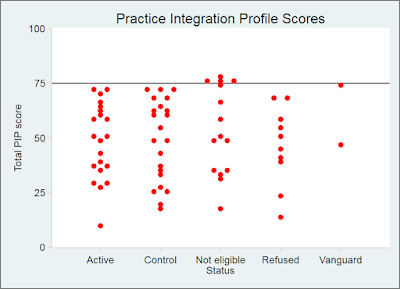To be eligible for the IBH-PC study, a practice needed to have a Total PIP score of no more than 75. This was to avoid recruiting practices that are already so well integrated that the IBH-PC redesign intervention just doesn't make sense. Why spend a lot of time and effort to integrate when you are already well-integrated?
Of the 118 practices we considered for the study, 70 provided at least 4 PIP surveys by various clinic staff. The Total PIP scores averaged 50 and ranged from 10 to 78. The 43 randomized clinics averaged 49 and ranged from 10 to 73. (The four practices with scores above 75 were ineligible.)
Happily, the stratified randomization worked as planned: the Active and Control groups are very similar in terms of both mean (48 vs. 49) and median (50 vs. 52), with P>0.9 by both Student's t and Wilcoxon rank-sum tests.
N.B.: Some of these PIPs were collected many months before the study actually began at the sites, so all randomized sites submit another wave of PIPs to be used as the baseline in the study analysis.
-Ben Littenberg


No comments:
Post a Comment